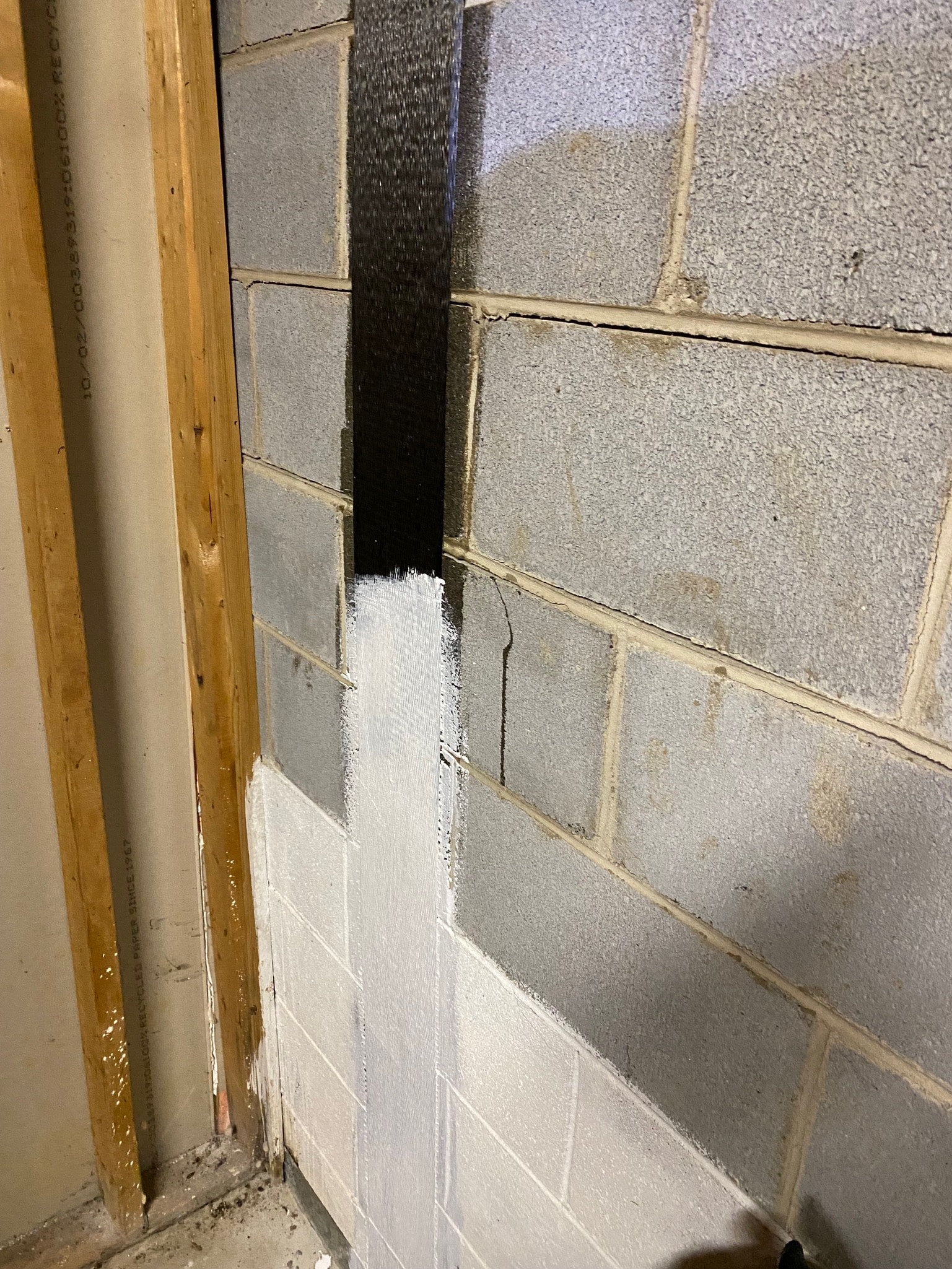
You’ve probably heard of carbon fiber straps, but have you ever wondered how they prevent foundation wall movement? These high-strength straps, when adhered to your foundation walls, act as a formidable barrier against soil pressures and environmental factors. They evenly distribute loads, preventing cracks and shifts in your foundation. Imagine a solution that not only enhances the longevity of your foundation but also cuts down on maintenance costs. Intriguing, isn’t it? There’s more to these carbon fiber straps than meets the eye.
Key Takeaways
- Carbon fiber straps counteract soil conditions and environmental factors that cause wall instability by providing high strength-to-weight support.
- The straps are applied vertically from base to top, effectively reinforcing the foundation wall and preventing further movement.
- Resistant to temperature changes, carbon fiber straps don’t expand or contract, thus maintaining their structural integrity.
- The straps’ corrosion resistance and durability ensure longevity, even in harsh conditions, reducing the risk of wall movement over time.
- Compared to traditional methods, carbon fiber straps offer a longer-lasting solution, effectively minimizing the need for recurrent repairs due to wall movement.
Understanding Foundation Wall Movement
Detecting foundation wall movement in your home is essential to maintaining its structural integrity. You might be wondering, “What causes foundation instability?” Several factors, including soil conditions, improper drainage, and construction defects, can lead to this problem.
When these causes are left unchecked, your home’s foundation might start moving, leading to potential damage and a decrease in your property’s value.
The first step in addressing this issue is a structural integrity assessment. This evaluation identifies the extent of the wall movement and the necessary steps to correct it. You’ll need a professional to conduct this assessment, ensuring accurate results.
In some cases, slight wall movement mightn’t indicate a serious problem. However, when the movement is significant or continuous, it’s a clear sign of foundation instability.
Cracks in the walls, uneven floors, and doors or windows that don’t fit correctly anymore are common signs that your foundation is moving.
Understanding foundation wall movement isn’t just about identifying the problem, it’s also about proactive prevention. Regular maintenance, early detection, and prompt repair can save you from expensive structural damage in the future.
What Are Carbon Fiber Straps?
While you may not be familiar with carbon fiber straps, they’re a game-changer in addressing foundation wall movement. These straps are a cutting-edge solution, boasting impressive carbon fiber properties and exceptional material durability.
- Lightweight but resilient: Carbon fiber straps weigh less than traditional steel reinforcements, but don’t be fooled by their lightness. They’re incredibly tough, and they can withstand immense pressure and stress without breaking or deforming.
- Corrosion-resistant: Unlike some other materials, carbon fiber doesn’t rust or deteriorate over time. This quality makes it an ideal choice for structures that need to withstand the elements for a long period.
- Ease of installation: They’re flexible and easy to work with, reducing the time and labor needed for installation.
These straps are designed to stabilize and strengthen your foundation walls, preventing any future movement or deterioration. They work by countering the pressure exerted on the walls, ensuring your home stands firm and safe.
With their excellent combination of strength, durability, and ease of use, carbon fiber straps are undoubtedly a powerful tool in your arsenal against foundation wall movement.
The Science Behind Carbon Fiber
Before diving into the specifics, it’s essential to understand what exactly carbon fiber is. It’s a material made up of thin strands of carbon atoms, arranged in a crystal structure. This structure gives carbon fiber its unique properties and exceptional material durability.
One of the key carbon fiber properties is its remarkable strength-to-weight ratio. It’s stronger than steel yet lighter than aluminum, making it ideal for applications where high strength and low weight are critical. Think about it, you’re getting the power of steel without the heaviness.
Carbon fiber is also highly resistant to changes in temperature, which means it won’t expand or contract significantly under extreme conditions. This stability makes it perfect for use in foundations, where consistent shape and size are crucial.
It’s worth noting that carbon fiber is also resistant to chemical corrosion. So, it won’t wear out or degrade quickly when exposed to harsh substances. This means you won’t have to worry about constant replacements or repairs.
Installation Process of Carbon Fiber Straps
When it’s time to install carbon fiber straps for your foundation, you’ll appreciate the straightforward process. Utilizing effective strap installation techniques, these straps can be implemented to reinforce your walls and prevent any unwanted movement.
- Preparation: The first step involves cleaning the wall surface to ensure optimal adhesion and then marking the areas where the straps will be affixed.
- Application: Next, epoxy resin is applied to the wall and the carbon fiber strap. The strap is then placed onto the resin-coated wall surface, ensuring the strap runs vertically from the base of the wall to the top.
- Finishing: Finally, another layer of epoxy is applied over the strap to secure it in place. This layer acts as a sealant to protect the strap and further enhance the bond.
These wall reinforcement strategies using carbon fiber straps aren’t just highly effective, but also relatively simple to execute.
But remember, while the process is straightforward, you must always prioritize safety and precision during installation.
A well-installed carbon fiber strap can make a world of difference in maintaining the structural integrity of your foundation.
Features and Benefits of Carbon Fiber Straps
In the world of foundation repair, carbon fiber straps stand out for their unique features and exceptional benefits. You’ll find these straps to be incredibly durable. This isn’t just speculation, it’s a fact proven through rigorous durability testing. They can withstand the toughest conditions and remain unscathed.
These straps aren’t just strong, they’re also lightweight. This makes them easy to handle and transport, reducing the overall cost and hassle of your foundation repair.
Additionally, the installation techniques for these straps are simple and straightforward. You won’t need complex tools or a large team of workers. In fact, the installation can often be completed by a small crew in just a day.
But the benefits of carbon fiber straps don’t end with their strength and ease of installation. Once installed, they virtually disappear into your wall. They won’t interfere with any future plans you might’ve for your basement, like painting or finishing.
In the end, carbon fiber straps provide a strong, efficient, and aesthetically pleasing solution for your foundation repair needs. They’re the smart choice for preventing foundation wall movement.
Carbon Fiber Straps vs. Traditional Solutions
Comparing carbon fiber straps to traditional solutions, it’s clear that the former offers distinct advantages. Traditional methods, often involving costly and disruptive excavation, can’t keep pace with modern innovations like carbon fiber straps.
Let’s break it down:
- Cost: Traditional methods involve significant labor and material costs. In contrast, carbon fiber straps are comparatively inexpensive and require less man-hours to install.
- Invasiveness: Traditional solutions typically require substantial disruption to your property. Carbon fiber straps, on the other hand, are less invasive, limiting the collateral damage to your landscaping.
- Effectiveness: Traditional methods might provide temporary relief, but they often fail in the long run. Carbon fiber straps offer a more durable and long-lasting solution.
Relying on outdated methods when superior products exist can prove costly and frustrating.
It’s time you embrace the modern innovations that carbon fiber straps represent. With their cost-effectiveness, minimal invasiveness, and proven durability, they’re a smart choice for combating foundation wall movement.
Say goodbye to the hassles of traditional methods and hello to the benefits of carbon fiber.
Case Studies of Carbon Fiber Straps
Let’s turn our attention now to a few case studies of carbon fiber straps.
We’ll explore how they’ve proven effective in real-life applications.
You’ll see concrete examples of how these straps have solved issues with foundation wall movement.
Carbon Fiber Straps Effectiveness
While you might be skeptical about the effectiveness of carbon fiber straps for foundation wall movement, real-life case studies paint a convincing picture.
These case studies showcase the role of carbon fiber in wall stabilization, making structures safer and more durable.
- Case Study One: A residential home experiencing severe wall movement was stabilized using carbon fiber straps. The homeowners were thrilled with the results, as the straps stopped further damage and stabilized the structure for the long term.
- Case Study Two: An old heritage building showing signs of wall movement was successfully reinforced with carbon fiber straps. The straps preserved the historical character of the structure while providing much-needed stability.
- Case Study Three: A commercial building with significant wall movement was secured using carbon fiber straps. The business owners appreciated the cost-effectiveness and quick installation process.
These cases clearly demonstrate the effectiveness of carbon fiber straps in preventing wall movement.
They’ve proven their worth in multiple scenarios, providing peace of mind to home and business owners alike.
Real-life Application Examples
Dive into these real-world examples that underscore the value and practicality of carbon fiber straps in various settings.
In Boston, a 19th-century brownstone was struggling with severe foundation wall movement due to soil erosion. Carbon fiber straps were installed, successfully overcoming this real world challenge. The homeowner’s testimonial praised the straps for their effectiveness and ease of installation.
In another instance, a commercial building in Seattle faced similar issues. Given the building’s age and the moist environment, the foundation was constantly under threat. Carbon fiber straps provided a long-lasting solution that was also cost-effective. The building manager’s testimonial detailed how the straps not only stabilized the foundation but also prevented future movement.
The versatility of carbon fiber straps was demonstrated in Houston where they were used to stabilize a hurricane-damaged home. Despite the harsh conditions, the straps held firm, effectively preventing further damage. The homeowner’s testimonial lauded the straps for their resilience and durability.
These examples highlight the real-world effectiveness of carbon fiber straps in preventing foundation wall movement. They’re not just theoretical solutions, but practical ones, tested and proven in the face of real world challenges.
Safety and Compliance Standards
When it comes to dealing with carbon fiber straps for foundation wall movement, you can’t turn a blind eye to safety and compliance standards. These standards aren’t just red tape; they’re designed to ensure that the straps you’re using are strong enough to do their job, safe to use, and in line with all regulatory requirements.
You need to check for three key things:
- Regulatory requirements: These are rules set by governing bodies to ensure safety and efficacy. Your carbon fiber straps should meet these standards to ensure they can firmly hold your foundation walls without causing any harm.
- Safety certifications: You don’t want to gamble with safety. Always opt for straps with safety certifications, proving that they’ve been rigorously tested and are safe to use.
- Manufacturer’s reputation: Finally, consider who’s making your straps. A reputable manufacturer won’t only comply with all safety and regulatory requirements but also stand behind their product.
Cost and Longevity Analysis
Before you invest in carbon fiber straps for your foundation wall movement, it’s crucial to consider both the cost and longevity of these products. Sure, the initial price tag might seem steep, but it’s important to conduct a thorough cost analysis to understand the long-term value.
Let’s look at this longevity comparison to better understand:
| Carbon Fiber Straps | Traditional Methods |
|---|---|
| High upfront cost | Lower upfront cost |
| Long-lasting (50+ years) | Requires frequent maintenance |
| Minimal future expenses | Recurring repair costs |
| Increased property value | Potential decrease in property value |
Though traditional methods might be cheaper initially, carbon fiber straps prove more cost-effective in the long run: they’re incredibly durable, often surpassing 50 years without needing replacement. This longevity minimises future repair expenses, ultimately saving you money.
On the flip side, traditional solutions often demand regular maintenance, racking up repair costs over time. These methods may also lead to a decrease in your property’s value, unlike carbon fiber straps, which can actually increase it.
Finding Reliable Carbon Fiber Strap Providers
Often, the success of your foundation wall movement project hinges on choosing a reliable carbon fiber strap provider.
Don’t underestimate the importance of this step. It’s not just about buying a product; it’s about partnering with a supplier who can provide quality materials and offer valuable support throughout your project.
- Research potential suppliers: Start by conducting a thorough online search for reliable suppliers. Check out reviews and ratings, and don’t hesitate to ask for recommendations from industry professionals.
- Verify product quality: Pay close attention to the materials used in the straps. High-quality carbon fiber straps resist corrosion and have high tensile strength.
Be wary of suppliers that offer suspiciously low-priced products; they may be compromising on quality.
- Check for product warranties: A warranty can be a lifesaver. Look for suppliers that offer warranties on their products.
This not only assures you of the product’s durability but also provides a safety net in case of any unexpected issues.
Frequently Asked Questions
Are Carbon Fiber Straps Suitable for All Types of Soil Conditions?
Yes, carbon fiber straps are suitable for all soil types.
They’re versatile and easy to install, adapting to various soil conditions. You don’t need to worry about soil type affecting your installation methods.
Whether it’s clay, silt, or sand, these straps can handle it. They’re designed to resist soil pressure and stabilize your walls, preventing any movement.
Can Carbon Fiber Straps Be Used on Historical Buildings?
Yes, you can use carbon fiber straps on historical buildings.
They’re a great tool for historical preservation because they maintain the building’s aesthetic while enhancing its structural integrity.
They’re thin, so they don’t change the appearance drastically. Plus, they’re incredibly strong, ensuring the building’s walls won’t shift over time.
Do Carbon Fiber Straps Affect the Aesthetic Appearance of the Building?
Yes, carbon fiber straps can affect a building’s aesthetics.
However, with careful design considerations, you can minimize this impact. It’s possible to paint over them or hide them within architectural details, enhancing aesthetic integration.
They’re much more discreet than other reinforcement methods.
So, while they might alter your building’s look slightly, they won’t detract from its overall appeal.
It’s all about how you choose to incorporate them into your building’s design.
Can Carbon Fiber Straps Be Installed in Extreme Weather Conditions?
You can install carbon fiber straps in extreme weather conditions, but it’s not ideal.
Cold temperatures may pose installation challenges as adhesives used may not bond properly.
Heat, on the other hand, can make the straps more pliable and difficult to handle.
How Are Carbon Fiber Straps Maintained Over the Long Term?
Maintaining carbon fiber straps over the long term isn’t complex.
You’ll need to use proven installation techniques from the start, ensuring they’re properly affixed.
Monitor their performance regularly to detect any changes early.
If you notice any loosening or damage, don’t hesitate to seek professional help.
Conclusion
So, you’ve seen how carbon fiber straps can halt foundation wall movement. They’re robust, easy to install, and offer long-term durability against soil and environmental pressures. By distributing loads evenly, they minimize cracking and shifting. Not only do they extend your foundation’s lifespan, but they also cut down on maintenance costs. Thus, it’s a smart, cost-effective choice. Make sure to find a reliable provider and enhance your home’s stability today.

Seal-tite Basement Waterproofing Co. is a full service basement environment contractor. We carry an A+ Better Business Bureau rating. We repaired over 40,000 homes and structures in Virginia, West Virginia, Tennessee, and North Carolina. We are fully insured and licensed. We have worked in all types of locations, including residential and commercial locations, government agencies, colleges, hospitals, churches, and condo associations.
Seal-tite® offers a lifetime transferable warranty. We carry a Class A Contractor’s License and we are fully insured. Our satisfied customers range from government agencies to businesses, hospitals, colleges, churches, and thousands of homeowners. Your home is probably the single largest investment you will make in your lifetime. Don’t wait, call Seal-tite® to help make your home dry, safe and livable.

